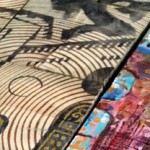Eighty-eight days ago I started reading through the Bible on a 90-day plan. I’ve stuck with it and am one book away from finishing the entire Bible. I’ve read through it using yearly plans quite a few times throughout my life, but this is the first I’ve tried a plan shorter than a year.
My expectation was that I’d be reading so much in so little time that it wouldn’t sink in and would simply be a “quick review.” But that was far from the case. When you’re reading fourteen to eighteen chapters a day, you cover many single books in one sitting. Even the largest of books you cover in just a few days.
Take the book of Ezekiel, for instance. When you only read three chapters a day, by the time you reach the end, what you read at the beginning has faded. But when you cover the entire book in three days, you get a sense of the cohesiveness and the timeline. Or, when you read about the kings of Judah and Israel and then read all the prophets had to say to them and about them, it all takes shape in a very fresh and concrete way.
But most interesting was having read the Old and New Testaments so close together. When Luke, Matthew and Peter quote the prophets of the Old Testament, you clearly remember having just read the original passages and even their context. When Jesus speaks of Noah, Moses and Elijah, their stories are fresh in mind. When Paul expounds in detail to the Romans about the gentiles being accepted by God, you’re filled with wonder, joy and understanding having just read the stories of Abraham, Isaac and Jacob, and the rejection of God by his own chosen people.
It reinforced more than ever that along with creation itself, the Bible is the ultimate model of creativity and design.
There are tales of heroes and villains. Mix in stories of treason and redemption, and the roles of hero and villain are not as clear cut as you initially expect. The stories constantly intersect—what Seinfeld did with storytelling is nothing new. Lives intersect and interrupt each other, and stories constantly intersect across generations, centuries and even millennia. When it comes to prophecy there is constant repetition and constant rebellion. There is poetry and there are proverbs. There are words of wisdom and tales of sex and murder. There are stories of judges and kings, miracles and the mundane, valor and fear, and there are terrifying visions of things to come.
There’s even a part 1 and a part 2. We call them the Old and New Testaments. The Old Testament is constantly pointing in various creative ways to the coming Messiah. Then, at the opening of part 2, the Messiah, Christ, arrives and the rest of the New Testament points back saying, “He has come!” Make no mistake that from the stories of murder, to tales of kings, to the words of the prophets lips, to the establishment of the church, to the visions of the future, this book is all about Jesus.
Its setting is the timeline of the world, starting with its very creation. This fact begs you to understand two things: the words of this book are the words of God himself, and the story is not yet complete.
This demands action, for our short timelines are part of this larger timeline. And if the larger timeline constantly points to Christ, the only thing that makes sense is for my life—my timeline—to point to Christ as well. The world is a mess today and people blindly call followers of Christ foolish and an offense without ever having read the book. In other words, nothing has changed. For Jesus clearly stated this would be the case.
If good design comes down to the effective interaction of elements in order to relay a clear message, the Bible is the ultimate example of and guide for design. And while that is something I hope to study in more detail, at this time of year all I want to do is focus on the climax of this amazing story—the arrival of Christ. The passage that blows my mind the most in terms of it’s weight, it’s significance, and it’s overwhelming beauty is the first five verses of the Gospel of John. Here we read the ultimate intersection of theology, poetry, drama, truth, and hope:
In the beginning was the Word, and the Word was with God, and the Word was God. He was in the beginning with God. All things were made through him, and without him was not any thing made that was made. In him was life, and the life was the light of men. The light shines in the darkness, and the darkness has not overcome it.




What reading plan did you use?
Hi Jon. I used the YouVersion Bible app for my reading. The plan I followed was simply titled “Bible in 90 Days.”